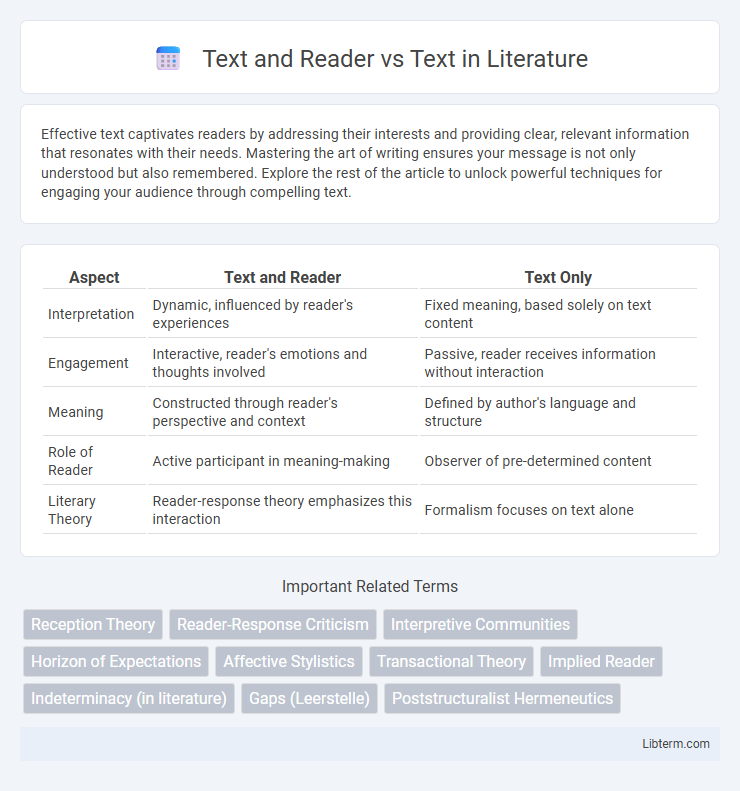Effective text captivates readers by addressing their interests and providing clear, relevant information that resonates with their needs. Mastering the art of writing ensures your message is not only understood but also remembered. Explore the rest of the article to unlock powerful techniques for engaging your audience through compelling text.
Table of Comparison
| Aspect | Text and Reader | Text Only |
|---|---|---|
| Interpretation | Dynamic, influenced by reader's experiences | Fixed meaning, based solely on text content |
| Engagement | Interactive, reader's emotions and thoughts involved | Passive, reader receives information without interaction |
| Meaning | Constructed through reader's perspective and context | Defined by author's language and structure |
| Role of Reader | Active participant in meaning-making | Observer of pre-determined content |
| Literary Theory | Reader-response theory emphasizes this interaction | Formalism focuses on text alone |
Understanding "Text and Reader" vs "Text" Approaches
The "Text and Reader" approach emphasizes the interaction between the reader's prior knowledge, experiences, and interpretive strategies with the text, enhancing comprehension through personal meaning-making. In contrast, the "Text" approach focuses solely on the intrinsic elements of the text such as structure, language, and content, treating meaning as fixed and independent of reader interpretation. Understanding these approaches aids in developing more effective reading strategies that balance textual analysis with reader response for deeper understanding.
Defining "Text": What Does It Encompass?
Text encompasses any coherent sequence of signs, symbols, or words intended to convey meaning, including written, spoken, digital, and visual forms. It serves as a medium through which ideas, narratives, and information are communicated, extending beyond traditional print to multimedia and hypertext environments. Defining text requires recognizing its dynamic nature, shaped by cultural, contextual, and interpretive factors that influence both creation and reception.
The Role of the Reader in Text Interpretation
The role of the reader in text interpretation emphasizes the active engagement and individual perspective they bring to the meaning-making process. Reader-response theory highlights how personal experiences, cultural background, and context shape the interpretation and understanding of the text. This interaction transforms the text from a fixed set of words into a dynamic space where meaning evolves uniquely for each reader.
Historical Development of Text-Centered Analysis
Text-centered analysis evolved through structuralism and formalism, emphasizing the autonomous nature of the text independent of authorial intent or reader response. Key figures like Ferdinand de Saussure and Roman Jakobson laid the groundwork by focusing on linguistic structures and literary devices inherent in the text. This approach dominated mid-20th-century literary criticism, shaping methodologies that prioritize textual evidence and internal coherence over external context or subjective interpretation.
Emergence of Reader-Response Criticism
Reader-response criticism emphasizes the active role of the reader in interpreting texts, challenging traditional views that prioritize authorial intent or textual stability. This theoretical approach emerged prominently in the 1960s and 1970s, influenced by scholars like Stanley Fish and Wolfgang Iser, who argued that meaning arises through the dynamic interaction between reader and text. The reader's individual experiences, cultural context, and cognitive engagement are seen as essential to the creation of literary meaning, shifting critical focus from the text alone to the reader-text relationship.
Comparing Authorial Intent vs Reader Perspective
Text and Reader theory contrasts authorial intent with reader perspective by emphasizing how meaning arises either from the creator's purpose or the individual interpretation of the audience. Authorial intent centers on the deliberate messages embedded by the writer, while reader perspective privileges subjective experience, cultural background, and personal context as shaping understanding. This dynamic highlights the fluidity of textual meaning, demonstrating that interpretation evolves beyond the fixed intentions of the author.
Meaning-Making: Fixed Text or Dynamic Interaction?
Text and reader interactions shape meaning-making through dynamic processes rather than fixed interpretations. Reader-response theory emphasizes that meanings emerge actively as readers interpret texts based on individual contexts, experiences, and emotions. This dynamic interaction challenges the notion of a single, static meaning embedded solely within the text.
Literary Examples: Applying Each Approach
Exploring "Text and Reader" through Roland Barthes' "The Death of the Author" reveals how reader interpretation shapes meaning beyond authorial intent, as seen in James Joyce's *Ulysses*, where fragmented narratives invite diverse readings. In contrast, the "Text vs Text" approach, exemplified by intertextual analysis of T.S. Eliot's *The Waste Land*, highlights textual relationships and allusions that construct meaning through dialogue with other works. These methods illuminate how literary texts engage readers either by privileging reader response or by emphasizing textual interconnectedness.
Theoretical Strengths and Limitations
Text and Reader theory emphasizes the active role of the reader in constructing meaning, highlighting the interpretative variability across different audiences and contexts. Its strength lies in acknowledging diverse perspectives, empowering individual engagement with texts, but it may underestimate the text's inherent structures and authorial intent, leading to subjective overinterpretations. Limitations include potential relativism and challenges in establishing definitive meaning, complicating objective analysis and consistent literary criticism.
Implications for Literary Scholarship
The distinction between Text and Reader in literary scholarship emphasizes the dynamic interaction where meaning is co-constructed rather than fixed. Reader-response theory highlights how individual readers' cultural contexts, experiences, and interpretations shape textual significance, challenging traditional author-centric analysis. This paradigm shift encourages scholars to consider diverse perspectives, broadening the scope of literary criticism and enriching textual analysis through subjective engagement.
Text and Reader Infographic

 libterm.com
libterm.com